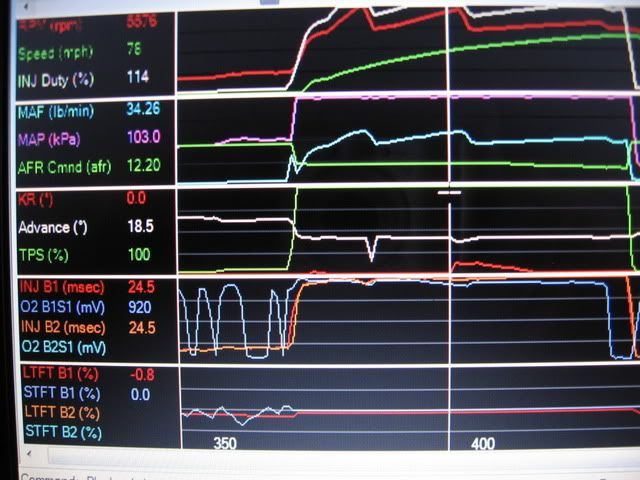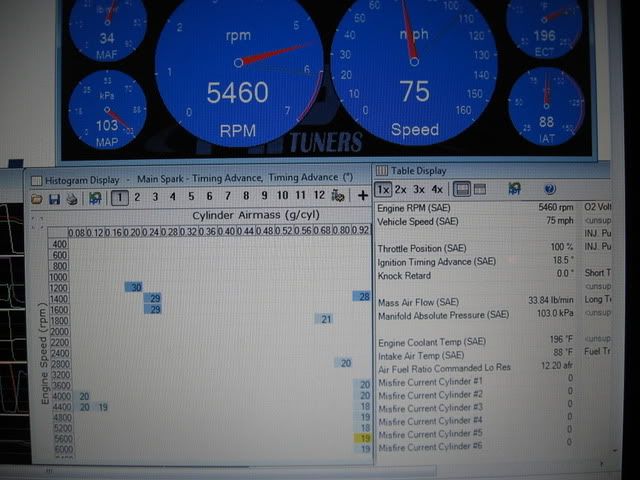
 |
Turbo Tuning
Quote:
My Friend |
First of all, that is the type of material that you would read BEFORE going to this site, after which you would then ask specifically what parts of it apply to tuning an Alero, which is actually not all that much.
Second, unless you own a dyno, it would not be cost effective or practical to do as many pulls as it would take to accomplish even half of those goals. Third, it is not a very good idea to incrementally adjust the whole timing table. The stock Alero timing tables are set aggressively to start with in the upper ranges, and across the board changes may affect the fueling at idle. |
Quote:
The dyno comment is a bit silly. If you rent time on a dyno by the hour you can get a lot done. When I was tuning the Grand Am we were on the thing for two hours doing pull after pull until we were satisfied for the night. We ended up tweaking the fuel to where the car liked it, and then added a whole bunch of timing across the entire fuel table for our c16fuel tune, and 100octane fuel tunes. Dyno time is priceless. |
i think it goes for like $500 for a full day around denver.......lol
|
500$ is a good price for a good tune, JMHO
|
Quote:
Last time I went, it cost $80.00 per 3 pulls. Of course, if you tune exclusively with the dyno starting from scratch, the first couple pulls will be used up to get baseline readings. After the first pull, the engine will most likely be a whole order of magnitude hotter, which will skew the results. Time is money, so the operator likely won't let you sit there and let it cool. In the case of my 3400, the main value of the dyno was to show me how good or bad my street / track tuning was. If you have HP Tuners or DHP, you would already have settled on what max timing at WOT is for your car, and how the ambient temps affect it. How did the operator measure AFR at WOT? So you got your tune lined out on street fuel, then drained and refilled the tank and retuned for "c16" and drained it again and retuned for 100 octane? In 2 hours? You Da Man! |
Reinstalling the rocker arms
Ignore the title^^
but would it be better off to buy the tuning program or to get it tuned by a shop? |
my tune and all day dyno session cost me 300 bones =P
|
okay so would i be better off getting a tune or having a shop tune it for me?
|
Quote:
We paid $100 for our 2 hours of time on the mustang dyno. At the time I had my wideband hooked up to my laptop, and the dyno operator had his wideband hooked up to my downpipe *didn't have an exhaust or cat at the time*. My street tune is 100octane, the biggest changes we made between 100octane and c16 was the timing. The engine was never hot persay, it was at operating temps. It also helps having two industrial sized monstrocities to help out. As long as I'm comfortable with the software I can tweak some good results out. |
On a turbo tune, you should never tweak the entire timing table "across the board" by a set amount. You should note that (depending on your engine and fuel type) there are certain timing amounts you should never exceed under boost. I particularly do not go beyond 15 degrees advance under boost with my setup in most ranges.
I'm always in learning mode finding new information and evaluating it, and opinions will vary. Spy and Greg, what are your opinions on this? |
Quote:
I also did not get good results with across the board timing changes, compared to tuning selected areas. That used to be the way tuning was done with devices such as a "MAF Translator", which I remember setting for +4 degrees base timing with a contour to (-2) degrees in the higher rpms. The car got more off the line power, but I was running less boost then, 6-8 lbs or so. That was fine, but after acquiring HP Tuners, scans indicated I was also getting a lot of KR at part throttle, midrange rpms. 15 degrees timing seems good for higher boost like you are running. I got more power when I went from 15 to 18 degrees at WOT (11-13 psi), but there were some days in the Summer when running in the heat, the PCM pulled it back a degree or two. I'll see if I can get a screenshot of the timing table I used. Edit: I hope this is readable, here are the latest High and Low Octane Main spark tables I used. It's a bit aggressive, not holding anything back going for low E.T.  |
This is the scan graph of my best (E.T.) run :
 The cursor line is set just before it hit third gear. I prefer that method of displaying data. You can easily see everything that went on during the run. There was 1.4 degrees of KR seen at the beginning of third gear. This is the Table/Histogam/Gauge display. The interesting thing here is that the IAT temp (measured at intake manifold) was 88 degrees F. at that point, but out of the supercharger it reaches well over 200 degrees.  Note how quickly the Cylinder Airmass maximum scale reading of 0.92 is reached, exceeding the capability of the stock PCM, at about 10-12 psi boost. This could be potential trouble for a turbo or centrifugal SC setup running high boost. Suppose the actual grams/cylinder is 1.04, or 1.16........does the PCM only read and respond to the timing set at 0.92? If so, a lower timing than needed at that value must be used to allow for safety in the unscanned range above it. |
| All times are GMT -4. The time now is 09:38 PM. |
Powered by vBulletin Version 3.6.0
Copyright ©2000 - 2025, Jelsoft Enterprises Ltd.